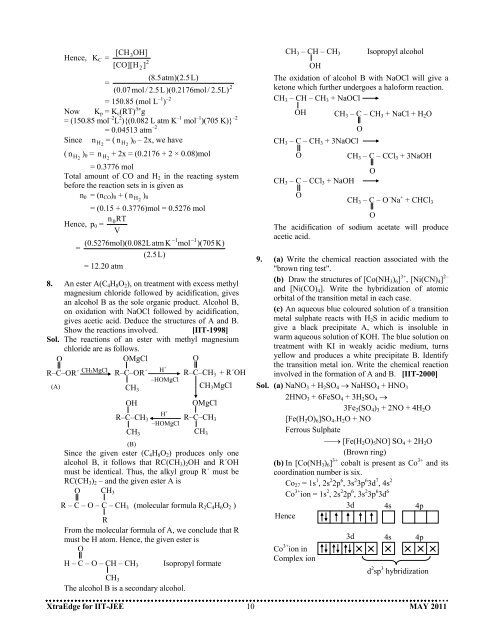May 2011 - Career Point
May 2011 - Career Point
May 2011 - Career Point
- No tags were found...
Create successful ePaper yourself
Turn your PDF publications into a flip-book with our unique Google optimized e-Paper software.
Hence, K C =[CH OH]3[CO][H2]2(8.5atm)(2.5L)=2(0.07 mol / 2.5L )(0.2176mol / 2.5L)= 150.85 (mol L –1 ) –2Now K p = K c (RT) ∆v g= (150.85 mol –2 L 2 ){(0.082 L atm K –1 mol –1 )(705 K)} –2= 0.04513 atm –2Since n = ( n ) 0 – 2x, we have( n ) 0 =H 2H 2n H 2H 2+ 2x = (0.2176 + 2 × 0.08)mol= 0.3776 molTotal amount of CO and H 2 in the reacting systembefore the reaction sets in is given asn 0 = (n CO ) 0 + ( n H 2) 0= (0.15 + 0.3776)mol = 0.5276 molnHence, p 0 = 0 RTV=(0.5276mol)(0.082L atm K(2.5L)= 12.20 atm−1 −1mol)(705K)8. An ester A(C 4 H 8 O 2 ), on treatment with excess methylmagnesium chloride followed by acidification, givesan alcohol B as the sole organic product. Alcohol B,on oxidation with NaOCl followed by acidification,gives acetic acid. Deduce the structures of A and B.Show the reactions involved. [IIT-1998]Sol. The reactions of an ester with methyl magnesiumchloride are as follows.OOMgClOCHR–C–OR´ 3MgClHR–C–OR´+R–C–CH 3 + R´OH–HOMgCl(A)CH 3CH 3 MgClOHOMgClHR–C–CH 3–HOMgClR–C–CH 3CH 3CH 3(B)Since the given ester (C 4 H 8 O 2 ) produces only onealcohol B, it follows that RC(CH 3 ) 2 OH and R´OHmust be identical. Thus, the alkyl group R´ must beRC(CH 3 ) 2 – and the given ester A isO CH 3R – C – O – C – CH 3(molecular formula R 2 C 4 H 6 O 2 )RFrom the molecular formula of A, we conclude that Rmust be H atom. Hence, the given ester isOH – C – O – CH – CH 3CH 3The alcohol B is a secondary alcohol.Isopropyl formateCH 3 – CH – CH 3Isopropyl alcoholOHThe oxidation of alcohol B with NaOCl will give aketone which further undergoes a haloform reaction.CH 3 – CH – CH 3 + NaOClOHCH 3 – C – CH 3 + 3NaOClOCH 3 – C – CCl 3 + NaOHOCH 3 – C – CH 3 + NaCl + H 2 OOCH 3 – C – CCl 3 + 3NaOHOThe acidification of sodium acetate will produceacetic acid.OCH 3 – C – O – Na + + CHCl 39. (a) Write the chemical reaction associated with the"brown ring test".(b) Draw the structures of [Co(NH 3 ) 6 ] 3+ , [Ni(CN) 4 ] 2–and [Ni(CO) 4 ]. Write the hybridization of atomicorbital of the transition metal in each case.(c) An aqueous blue coloured solution of a transitionmetal sulphate reacts with H 2 S in acidic medium togive a black precipitate A, which is insoluble inwarm aqueous solution of KOH. The blue solution ontreatment with KI in weakly acidic medium, turnsyellow and produces a white precipitate B. Identifythe transition metal ion. Write the chemical reactioninvolved in the formation of A and B. [IIT-2000]Sol. (a) NaNO 3 + H 2 SO 4 → NaHSO 4 + HNO 32HNO 3 + 6FeSO 4 + 3H 2 SO 4 →3Fe 2 (SO 4 ) 3 + 2NO + 4H 2 O[Fe(H 2 O) 6 ]SO 4 .H 2 O + NOFerrous Sulphate⎯→ [Fe(H 2 O) 5 NO] SO 4 + 2H 2 O(Brown ring)(b) In [Co(NH 3 ) 6 ] 3+ cobalt is present as Co 3+ and itscoordination number is six.Co 27 = 1s 1 , 2s 2 2p 6 , 3s 2 3p 6 3d 7 , 4s 2Co 3+ ion = 1s 2 , 2s 2 2p 6 , 3s 2 3p 6 3d 6HenceCo 3+ ion inComplex ion3d 4s 4p3d 4s 4pd 2 sp 3 hybridizationXtraEdge for IIT-JEE 10 MAY <strong>2011</strong>

















